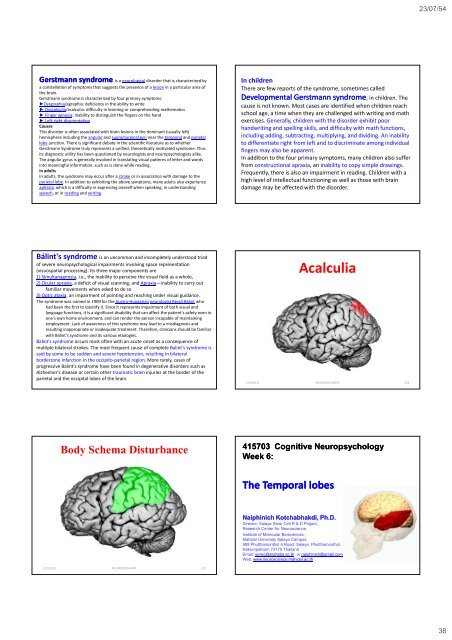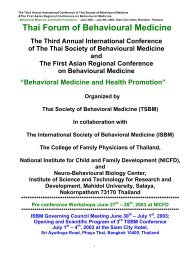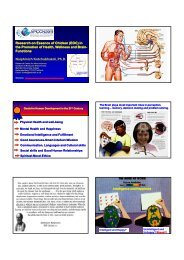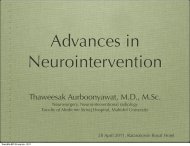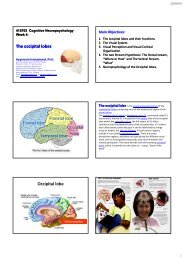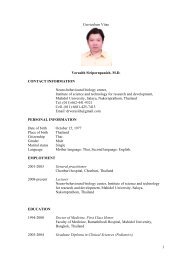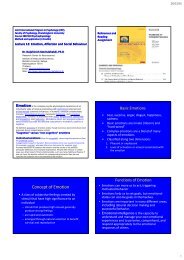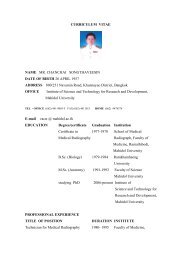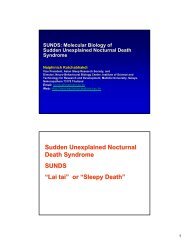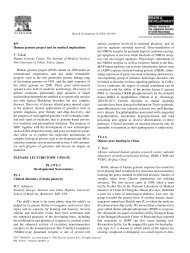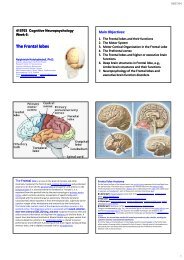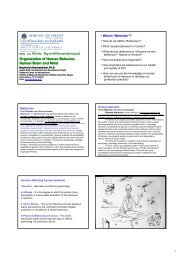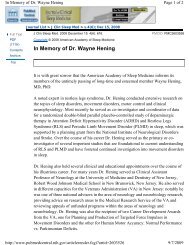Neurological Examination, clinical cases and neuropsychological ...
Neurological Examination, clinical cases and neuropsychological ...
Neurological Examination, clinical cases and neuropsychological ...
Create successful ePaper yourself
Turn your PDF publications into a flip-book with our unique Google optimized e-Paper software.
23/07/54<br />
Gerstmann syndrome is a neurological disorder that is characterized by<br />
a constellation of symptoms that suggests the presence of a lesion in a particular area of<br />
the brain.<br />
Gerstmann syndrome is characterized by four primary symptoms:<br />
►Dysgraphia/agraphia: deficiency in the ability to write<br />
► Dyscalculia/acalculia: difficulty in learning or comprehending mathematics<br />
► Finger agnosia: inability to distinguish the fingers on the h<strong>and</strong><br />
► Left‐right disorientation<br />
Causes<br />
This disorder is often associated with brain lesions in the dominant (usually left)<br />
hemisphere including the angular <strong>and</strong> supramarginal gyri near the temporal <strong>and</strong> parietal<br />
lobe junction. There is significant debate in the scientific literature as to whether<br />
Gerstmann Syndrome truly represents a unified, theoretically motivated syndrome. Thus<br />
its diagnostic utility has been questioned by neurologists <strong>and</strong> neuropsychologists alike.<br />
The angular gyrus is generally involved in translating visual patterns of letter <strong>and</strong> words<br />
into meaningful information, such as is done while reading.<br />
In adults<br />
In adults, the syndrome may occur after a stroke or in association with damage to the<br />
parietal lobe. In addition to exhibiting the above symptoms, many adults also experience<br />
aphasia, which is a difficulty in expressing oneself when speaking, in underst<strong>and</strong>ing<br />
speech, or in reading <strong>and</strong> writing.<br />
In children<br />
There are few reports of the syndrome, sometimes called<br />
Developmental Gerstmann syndrome, in children. The<br />
cause is not known. Most <strong>cases</strong> are identified when children reach<br />
school age, a time when they are challenged with writing <strong>and</strong> math<br />
exercises. Generally, children with the disorder exhibit poor<br />
h<strong>and</strong>writing <strong>and</strong> spelling skills, <strong>and</strong> difficulty with math functions,<br />
including adding, subtracting, ti multiplying, l i <strong>and</strong> dividing. idi An inability<br />
to differentiate right from left <strong>and</strong> to discriminate among individual<br />
fingers may also be apparent.<br />
In addition to the four primary symptoms, many children also suffer<br />
from constructional apraxia, an inability to copy simple drawings.<br />
Frequently, there is also an impairment in reading. Children with a<br />
high level of intellectual functioning as well as those with brain<br />
damage may be affected with the disorder.<br />
Bálint's syndrome is an uncommon <strong>and</strong> incompletely understood triad<br />
of severe <strong>neuropsychological</strong> impairments involving space representation<br />
(visuospatial processing). Its three major components are<br />
1) Simultanagnosia, i.e., the inability to perceive the visual field as a whole,<br />
2) Ocular apraxia, a deficit of visual scanning, <strong>and</strong> Apraxia—inability to carry out<br />
familiar movements when asked to do so<br />
3) Optic ataxia, an impairment of pointing <strong>and</strong> reaching under visual guidance.<br />
The syndrome was named in 1909 for the Austro‐Hungarian neurologist Rezső Bálint who<br />
had been the first to identify it. Since it represents impairment of both visual <strong>and</strong><br />
language functions, it is a significant disability that can affect the patient's safety even in<br />
one's own home environment, <strong>and</strong> can render the person incapable of maintaining<br />
employment. Lack of awareness of this syndrome may lead to a misdiagnosis <strong>and</strong><br />
resulting inappropriate or inadequate treatment. Therefore, clinicians should be familiar<br />
with Bálint's syndrome <strong>and</strong> its various etiologies.<br />
Balint's syndrome occurs most often with an acute onset as a consequence of<br />
multiple bilateral strokes. The most frequent cause of complete Balint's syndrome is<br />
said by some to be sudden <strong>and</strong> severe hypotension, resulting in bilateral<br />
borderzone infarction in the occipito‐parietal region. More rarely, <strong>cases</strong> of<br />
progressive Balint's syndrome have been found in degenerative disorders such as<br />
Alzheimer's disease or certain other traumatic brain injuries at the border of the<br />
parietal <strong>and</strong> the occipital lobes of the brain.<br />
Acalculia<br />
7/23/2011 NEUROPSYCHIATRY 226<br />
Body Schema Disturbance<br />
415703 Cognitive Neuropsychology<br />
Week 6:<br />
The Temporal lobes<br />
7/23/2011 NEUROPSYCHIATRY 227<br />
Naiphinich Kotchabhakdi, Ph.D.<br />
Naiphinich Kotchabhakdi, Ph.D.<br />
Director, Salaya Stem Cell R & D Project,<br />
Research Center for Neuroscience,<br />
Institute of Molecular Biosciences,<br />
Mahidol University Salaya Campus,<br />
999 Phutthamonthol 4 Road, Salaya, Phutthamonthol,<br />
Nakornpathom 73170 Thail<strong>and</strong><br />
Email: scnkc@mahidol.ac.th or naiphinich@gmail.com<br />
Web: www.neuroscience.mahidol.ac.th<br />
38


